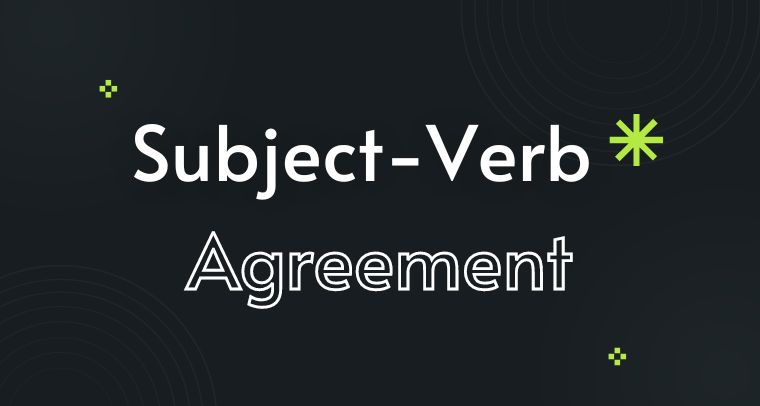The rules of the Subject-Verb Agreement are pretty simple. Just make sure the verb agrees with the subject in number. That is, use a singular verb with a singular subject and a plural verb with a plural subject. The subject is who or what performs the action in a sentence (for example: “He walks” or “She runs”). The verb is what’s being done (for example: “Walking” or “Running”). If you don’t know which word to use in a certain situation, keep reading! We’ll explain all about the subject-verb agreement below.
The Basic Agreement Rules
Subjects and verbs must agree with one another in number (singular or plural). Thus, if a subject is singular, its verb must also be singular; if a subject is a plural, its verb must also be plural. The subject is the noun or pronoun that performs the action of the verb. The verb is what does the action, and it must agree with its subject in person, number, and gender (that’s right—no exceptions).
That said, there are some exceptions to this rule:
- You can have a singular subject with plural verbs: “The boys are playing football.” * You can have a plural subject with singular verbs: “My friends are going camping tomorrow.” * You can have an object that’s not mentioned directly by another word (like “to” or “for”). It will still be considered part of your sentence if you’re talking about it later on in your sentence or paragraph.
- In addition, remember that collective nouns (e.g., group, team, jury, family, class) usually take a singular verb but can take a plural verb when the members of the group are acting as individuals.
Indefinite pronouns
Indefinite pronouns are always singular, even if they refer to a group of people or things. Some indefinite pronouns are anybody, anyone, anything, each, either, everybody, everyone, everything, neither, nobody, no one, nothing, one, somebody, someone. To make sure you have a subject-verb agreement, you need to identify the subject and make sure the verb agrees with it in number.
Compound subjects
Some subjects are compound, which means they are two or more subjects that are connected by a conjunction (e.g. and, or, but). In these cases, the verb must agree with the subject that is closest to it. For example:
- One of my friends is going to law school and the other is getting married.
In this sentence, there are two subjects (my friends) that are connected by the conjunction “and”. The verb (“is going”) MUST
Compound subjects are always singular, meaning that only one of them can be used.
For example:
- The boy and girl were playing soccer in the park when we arrived.
- The boy and girl were playing soccer in the park when we arrived. (subject) *The boy was playing soccer in the park with his friend when we arrived.* (compound subject)
Subjects joined by “and”
The problem arises when the subject is a compound of two or more nouns joined by “and.” In such cases, most people are inclined to use a plural verb, even when the subject is singular. Thus, they will say things like “
Subjects joined by “or” or “nor”
In order for a sentence to be grammatically correct, the subject and verb must agree. This can become tricky when there is more than one subject, especially when those subjects are joined by “or” or “nor.” If the subjects are singular, the verb must be singular. If the subjects are plural, the verb must be plural. However, if one of the subjects is singular and the other is plural, the verb must agree with the subject that is closest to it. For example, Neither the dog nor the cats are eating their food. In this sentence, even though there are two subjects, the verb “is” agrees with the subject closest to it, which is “cats.”
Sometimes the Subject Is Hard to Find
You may have noticed that the subject of a sentence can be hard to find. It’s not always easy to spot, and sometimes it can be hidden in plain sight.
You might think this rule applies only when the verb is vague or unstated; for example, if you ask someone whether he wants coffee or tea (or anything else), he’ll probably say “I’d like some coffee.” But there are other times when the subject isn’t obvious at all: if your boss asks you what time you’re going home tonight and you don’t know how long your commute takes or which direction it takes you in—and so on—then perhaps he shouldn’t expect an answer! And even if you do know exactly how long each trip will take and where it starts from… well… maybe not everyone would want their boss knowing those details either! So what should we do with these situations?
Words that look plural but are singular
The English language is full of words that look like they should be plural, but are actually singular. These words can trip up even the most seasoned writers. Some of the most common words that look plural but are singular include data, media, alumnus/alumni, criterion, and phenomena. When in doubt, consult a dictionary or style guide to make sure you’re using these words correctly.
It should be easier now to write the subject-verb agreement
You’ve probably heard it before: “The cat chased the mouse.” The verb “chased” is in the present tense, and it agrees with its subject—the cat—in number and gender. This means that you have to be careful when writing sentences like these so that they’re grammatically correct. If you don’t follow proper grammar conventions (like using appropriate articles), your writing will sound choppy and confusing!
Conclusion
Subject-verb agreement is a basic grammatical rule that everyone should learn and follow. By understanding the different types of subjects and verbs, as well as the different ways to make them agree, you can avoid common errors in your writing.

